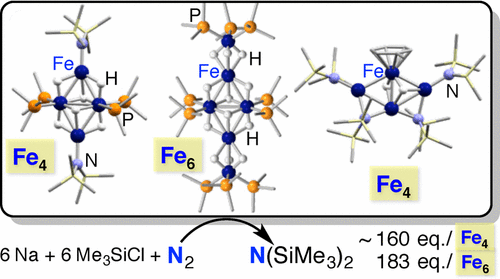当前位置:
X-MOL 学术
›
J. Am. Chem. Soc.
›
论文详情
Our official English website, www.x-mol.net, welcomes your
feedback! (Note: you will need to create a separate account there.)
[Fe4] and [Fe6] Hydride Clusters Supported by Phosphines: Synthesis, Characterization, and Application in N2 Reduction
Journal of the American Chemical Society ( IF 14.4 ) Pub Date : 2017-04-10 , DOI: 10.1021/jacs.7b01965 Ryoichi Araake , Kazuki Sakadani , Mizuki Tada , Yoichi Sakai 1 , Yasuhiro Ohki 2
Journal of the American Chemical Society ( IF 14.4 ) Pub Date : 2017-04-10 , DOI: 10.1021/jacs.7b01965 Ryoichi Araake , Kazuki Sakadani , Mizuki Tada , Yoichi Sakai 1 , Yasuhiro Ohki 2
Affiliation

|
Multiple iron atoms bridged by hydrides is a common structural feature of the active species that have been postulated in the biological and industrial reduction of N2. In this study, the reactions of an Fe(II) amide complex with pinacolborane in the presence/absence of phosphines afforded a series of hydride-supported [Fe4] and [Fe6] clusters Fe4(μ-H)4(μ3-H)2{N(SiMe3)2}2(PR3)4 (PR3 = PMe3 (2a), PMe2Ph (2b), PEt3 (2c)), Fe6(μ-H)10(μ3-H)2(PMe3)10 (3), and (η6-C7H8)Fe4(μ-H)2{μ-N(SiMe3)2}2{N(SiMe3)2}2 (4), which were characterized crystallographically and spectroscopically. Under ambient conditions, these clusters catalyzed the silylation of N2 to furnish up to 160 ± 13 equiv of N(SiMe3)3 per 2c (40 equiv per Fe atom) and 183 ± 18 equiv per 3 (31 equiv per Fe atom). With regard to the generation of the reactive species, dissociation of phosphine and hydride ligands from the [Fe4] and [Fe6] clusters was indicated, based on the results of the mass spectrometric analysis on the [Fe6] cluster, as well as the formation of a diphenylsilane adduct of the [Fe4] cluster.
中文翻译:

膦支持的 [Fe4] 和 [Fe6] 氢化物簇:合成、表征和在 N2 还原中的应用
由氢化物桥接的多个铁原子是在 N2 的生物和工业还原中假定的活性物质的共同结构特征。在这项研究中,Fe(II) 酰胺配合物与频哪醇硼烷在存在/不存在膦的情况下的反应提供了一系列氢化物负载的 [Fe4] 和 [Fe6] 簇 Fe4(μ-H)4(μ3-H) 2{N(SiMe3)2}2(PR3)4 (PR3 = PMe3 (2a), PMe2Ph (2b), PEt3 (2c)), Fe6(μ-H)10(μ3-H)2(PMe3)10 ( 3), 和 (η6-C7H8)Fe4(μ-H)2{μ-N(SiMe3)2}2{N(SiMe3)2}2 (4),通过晶体学和光谱学表征。在环境条件下,这些簇催化 N2 的甲硅烷基化,每 2c 提供高达 160±13 当量的 N(SiMe3)3(每个 Fe 原子 40 当量)和每 3 提供 183±18 当量(每个 Fe 原子 31 当量)。关于活性物种的产生,
更新日期:2017-04-10
中文翻译:

膦支持的 [Fe4] 和 [Fe6] 氢化物簇:合成、表征和在 N2 还原中的应用
由氢化物桥接的多个铁原子是在 N2 的生物和工业还原中假定的活性物质的共同结构特征。在这项研究中,Fe(II) 酰胺配合物与频哪醇硼烷在存在/不存在膦的情况下的反应提供了一系列氢化物负载的 [Fe4] 和 [Fe6] 簇 Fe4(μ-H)4(μ3-H) 2{N(SiMe3)2}2(PR3)4 (PR3 = PMe3 (2a), PMe2Ph (2b), PEt3 (2c)), Fe6(μ-H)10(μ3-H)2(PMe3)10 ( 3), 和 (η6-C7H8)Fe4(μ-H)2{μ-N(SiMe3)2}2{N(SiMe3)2}2 (4),通过晶体学和光谱学表征。在环境条件下,这些簇催化 N2 的甲硅烷基化,每 2c 提供高达 160±13 当量的 N(SiMe3)3(每个 Fe 原子 40 当量)和每 3 提供 183±18 当量(每个 Fe 原子 31 当量)。关于活性物种的产生,


















































 京公网安备 11010802027423号
京公网安备 11010802027423号